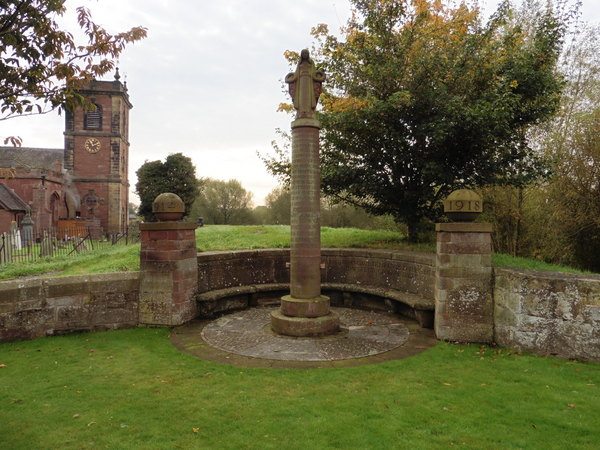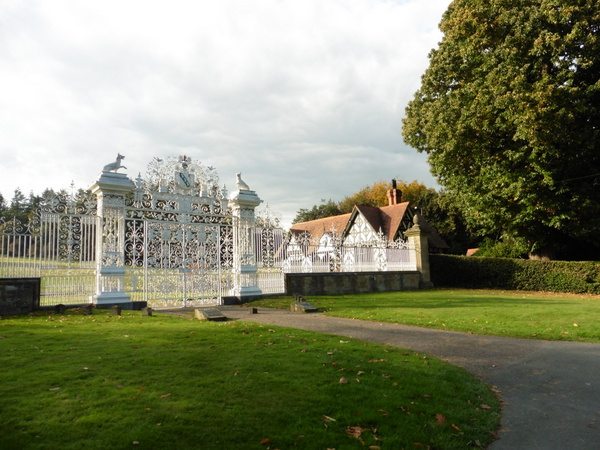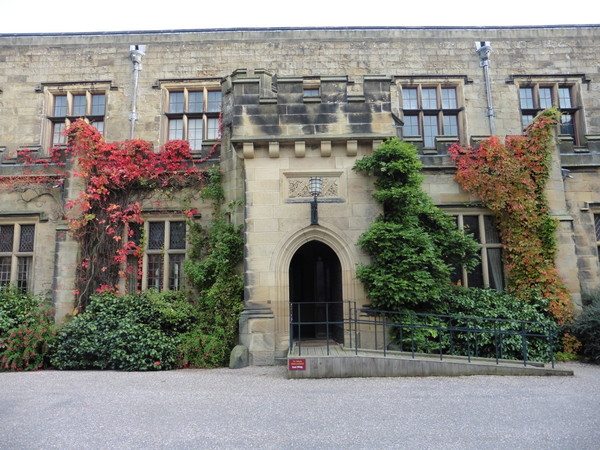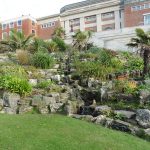Today we took a trip up to Pontcysyllte Aqueduct and Chirk Castle. They’re situated only a few miles apart in the North of Wales between Wrexham and Llangollen.
Bangor Is-Y-Coed (Bangor-On-Dee)

On the way up to Pontcysyllte Aqueduct we missed the turn off and by mistake turned onto the Bangor Is-Y-Coed (Bangor-On-Dee) road. We were quite surprised when we spotted an old bridge across the river.

Built from red sandstone with a single cobbled lane on top and pedestrian shelters on each side it was quite beautiful. As we passed up and over the bridge we were greeted by a lovely little village before us. Before us lay beautiful Tudor style pub, medieval buildings and a red sandstone church nearby. It was a place we just had to stop and check out.
We soon discovered the 95 metre long bridge was built in the 16th century from local stone and was designed with five arches. It was repaired in 1658 and again in 1996 when a tractor crashed into it. Judging by the state of the bridge there’s no reason why it won’t last another 500 years.

After checking out the bridge, the high street and the local war memorial we headed into the St Dunawd Church. The church gains its name from St Dunawd (St Dunod) who established a monastery nearby in AD560. The monastery was destroyed and supposedly 1200 monks were executed by Anglo-Saxon King Ethelfrith of Northumbria after the Battle of Chester .

Inside St Dunawds Church is a great display of the history of Bangor Is-coed. The three main points about Bangor Is-coed are the red sandstone church, the river and the racecourse.
St Dunawd’s Church, was supposedly built on the site of the monastery around 1300. It was expanded in the 1720’s and again in the late 1800’s. It’s a simple church with an aisle on either side of the nave and a chancel beyond. A Norman font with a carved wooden hood is a real highlight in the church. When the church was being renovated Roman tiles were found on the site showing that the site’s been in use for a long time.
When the River Dee floods the Main Street is inundated, however the church is built a little higher so escapes the floodwater.
Until the 20th century people would fish using coracles (round basket or skin boats) on the River Dee. The last remaining one from around Bangor Is-coed is now in the National Museum in Cardiff. These days people only fish on the river for fun. Another thing they do for fun is visit the Bangor Is-coed (Bangor-On-Dee) racecourse.
The racecourse opened in 1859 after a bet between local gentlemen. The race was a steeplechase for a purse of money and bragging rights. Since then it’s become an annual event. Competitors are prohibited from riding the course before hand and horses are highly scrutinised.
Set in a rural area, agriculture and related industry has always been the major employer around Bangor Is-coed. The Cadbury Chocolate factory was established near Bangor Is-coed in 1938, which attracted a lot of people to the area.
After the factory’s closure it was converted into a milk factory and remains in operation today.
After riding around Bangor Is-Y-coed (Bangor-On-Dee) we headed to the Pontcysyllte Aqueduct at Trevor.
Pontcysyllte Aqueduct

One of our bucket list items has been to travel in a canal boat and to cross Pontcysyllte Aqueduct. Today we got to tick off both with Jones The Boats, at Trevor, near Llangollen. The Pontcysyllte Aqueduct was designed by Thomas Telford and opened in 1805 after a ten year construction. The aqueduct is the highest (126 feet 8 inches) and longest (1007 feet) in Great Britain. The project used soil from construction further up the canal and cost cost £47,000.
When it was built the aqueduct was originally part of a project to connect with the countryside north of the canal. After the extension north was cancelled in favour of rail, Thomas Telford cut a deal with the industrial areas towards Crewe. In return for providing fresh water from Horseshoe Falls they’d patronise his canal extension towards local industry.
Thomas Telford lived in a stone house on the hill overlooking the aqueduct during his tenure at Pontcysyllte Aqueduct.

After boarding our canal boat we headed towards Pontcysyllte Aqueduct along the canal. Passing under a low bridge we entered Anglo Welsh wharf. With all the boats moored for the winter there was only room for only one canal boat to squeeze through. The Anglo-Welsh company also hire out boats on a daily rate on the Llangollen canal. We might have to look a little closer at this. It sounds like fun.

The Pontcysyllte Aqueduct is actually one lane so the barge skipper has to wait until it’s clear before crossing. When it was designed the aqueduct was built from cast iron troughs 8 feet with a 4 feet wide walkway beside it to allow for the horses which towed the barge. A safety rail was fitted on one side to prevent the horses from falling. Wear marks from the horses tow ropes in the cast iron handrail are all that’s left from the old days.

Crossing over the Pontcysyllte Aqueduct we had magnificent views across the valley. Below us we had views of the River Dee with a 15th century bridge and in the distance the railway bridge built in 1848. Supposedly when the bridge opened one of the first trains broke down on the bridge and the passengers were stranded.
All through the valley and on either side of the canal the beautiful autumn colours really make this time of year a perfect time to be visiting.
The canal is linked with canals throughout the country connecting cities such as London, Manchester, and Leeds. Being up on the aqueduct you get a feeling of just how immense the canal system is.
Jones The Boats are a family business who operate the cruises from April-Nov but are also available for private charter. For £7.00 you can enjoy a 45 minute narrowboat ride across the aquaduct.

After our tour we took a walk along the canal and across the aqueduct. As we walked back we chatted to the Jones barge captain. He was navigating his barge across the aqueduct and we easily kept pace with his barge chugging along 2 1/2 miles per hour. The old road from Trevor travels across the 15th century bridge so we took this route to see the aqueduct from the bottom. The view of the aqueduct from the bottom is even more spectacular with barges transiting across. A few miles from Pontcysyllte Aqueduct near the town of Chirk is Chirk Castle.
Chirk Castle (Castell y Waun)

Chirk Castle or Castell y Waun, (in Welsh) was Built in 1295 by Roger Mortimer de Chirk. It was part of King Edward I’s defensive line of fortresses across the north of Wales, built to pacify the welsh. The castle was bought by Sir Thomas Myddleton in 1593 the Lord Mayor of London and became the home of the Myddleton family.
Chirk Castle was seized by Royalist Forces in 1643 whilst Thomas Myddleton (the younger) was away leading Parliamentary Forces. Chirk Castle came under siege when Thomas besieged his own castle for three days in December 1644 before being beaten off by the Royalists.

He didn’t remain a parliamentarian for long, for he objected to the trial of the King. As a result he was forced to pay a £10,000 bond for a guarantee of his good behaviour and removed from parliament. At this stage Chirk Castle was returned to him. He didn’t hold it for very long. Thomas joined the Cheshire Uprising in 1659 and proclaimed Charles II the king. As a result parliamentary forces besieged Chirk Castle and Thomas was forced to surrender. The punishment Thomas and his brothers received was a notice to quit the country.
After the restoration of the monarchy in 1660 King Charles II awarded Thomas with £60,000 compensation and made him a Baronet.

After the last Myddleton male heir Richard, died in 1796 Chirk Castle passed to his sister Charlotte Myddleton. She married Robert Biddolph in 1801 who added Myddleton to his name. Their sons became very important to Queen Victoria. The eldest, Robert was member of parliament for Denbighshire, and a Colonel of the Denbigh Militia, Lord Lieutenant of Denbighshire, and an aide-de-camp to Queen Victoria
His younger brother Thomas served as a lieutenant of the Queens Lifeguards. He married one of the Queens Maids in Waiting and his career involved high ranking posts.
He was knighted, promoted to general plus held the posts of Receiver General of the Duchy of Cornwall, Receiver General of the Duchy of Lancaster, and Keeper of the Privy Purse, all at the same time. He died after a short illness at Abergeldie near Balmoral with Queen Victoria visiting daily.

During the 1930s the Castle was home to Thomas Scott-Ellis, 8th Baron Howard de Walden, a prominent patron of the arts and champion of Welsh culture. He was a quirky fellow who collected armour among other things. He would often wander around the castle dressed in Teutonic knights helm and armour. Thomas Scott-Ellis served in the British Army in the Boer War and later in the Great War. Whilst serving on the Somme he realised his troops were not equipped with fighting knives for use in trench warfare. To remedy this he wrote to the owners of Wilkinson sword requesting a knife based on a welsh. The knife with a wide flat blade could be carried flat against the hip and was perfect for close quarters fighting. It was to become the official knife of the welsh fusiliers. One of the stories associated with Thomas was one of running over a pedestrian in whilst racing around the backroads of Germany in a sports car. It turned out the pedestrian was none other than an Austrian known as A.Hitler.
The Myddletons kept their association with the royal as Lieutenant-Colonel Ririd Myddleton was an extra equerry to Queen Elizabeth II. The Myddelton family resided at Chirk Castle until 2004.

The National Trust operate Chirk Castle with various areas reflecting the former owners and tenants. The entry hall, known as the Cromwellian Hall is decorated with the heraldic shields displaying the Myddleton pedigree and heritage. Around the hall are displays many of the weapons from the English Civil War. These includes a large collection of dog lock muskets an English style flintlock mechanism which was only in use in England for about 40 years before falling into disuse. The English firearms date from prior to 1680 when they were purchased. The oldest dates from the 1640’s. There is also breast plates, armour, swords and pikes.
Another interesting item on display is a pair of bucket boots. They are boots which could be worn on either foot. Very handy in the troubled times (the English Civil War) which they date from.

The upper floor of the castle was decorated in 18th century styles. Pastel wallpapers with gold highlights, white plastered ceilings and tastefully decorated with high quality furniture. One of the hidden gems was the faces carved into the frames of the paintings. The craftsman had secretly carved gurning strange faces adding a bit of mirth to the quite serious portraits they surrounded. The lower rooms which housed the extensive library showcased medieval carved wooden walls and fireplace.
Thomas Scott-Ellis’ room featured gothic ceilings and windows. Around the room Thomas’ life is on display with displays of his armour, photo albums, diary and various items.
In another part of the castle the original style is kept with bare flagstone floors and walls. There’s areas for kids to dress up, play areas and activities. Like any good castle there’s a lovely cafe and a dungeon deep in the bowels for those who don’t pay their bills.
Chirk Castle was a lovely place to spend a few hours and we could’ve spent a few more hours exploring and learning the stories. The National Trust organise various activities associated with the castle and grounds for people of various ages or abilities. Visiting hours are available here
After a big day out and with the clouds rolling in it was time to head back towards Whitchurch. Tomorrow we are heading to check out Wrexham not far away.






